The Converged Data Platform Market is estimated to be valued at USD 5.8 billion in 2025 and is projected to reach USD 22.6 billion by 2035, registering a compound annual growth rate (CAGR) of 14.5% over the forecast period.
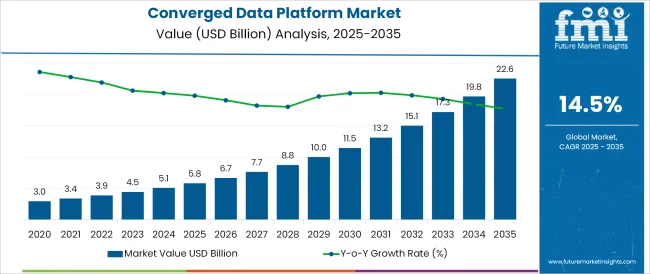
The converged data platform market is undergoing rapid transformation, fueled by the increasing enterprise demand for unified data infrastructure that simplifies operations reduces latency, and enhances agility.
The current market scenario is shaped by rising adoption of hybrid and multi-cloud strategies, with organizations actively seeking platforms that integrate compute, storage, and networking resources into a single solution. This shift is being propelled by pressure to modernize legacy IT systems, improve workload efficiency and reduce data management costs. As cybersecurity threats and compliance mandates continue to grow, converged solutions are increasingly valued for their streamlined architecture and centralized control
Furthermore, the growing relevance of AI and big data analytics is encouraging investments in platforms capable of real-time data processing and low-latency access. Future growth opportunities are expected to emerge from increased enterprise digital transformation initiatives, expansion of edge computing environments, and the integration of software defined components that enhance flexibility and scalability of data center operations.
The market is segmented by Type, Application, and Industry and region. By Type, the market is divided into VMware, KVM, and Hyper-V. In terms of Application, the market is classified into Virtual Desktop Infrastructure, Server Virtualization, and Data Protection. Based on Industry, the market is segmented into Healthcare, Government, Education, IT & Telecom, and Others. Regionally, the market is classified into North America, Latin America, Western Europe, Eastern Europe, Balkan & Baltic Countries, Russia & Belarus, Central Asia, East Asia, South Asia & Pacific, and the Middle East & Africa.
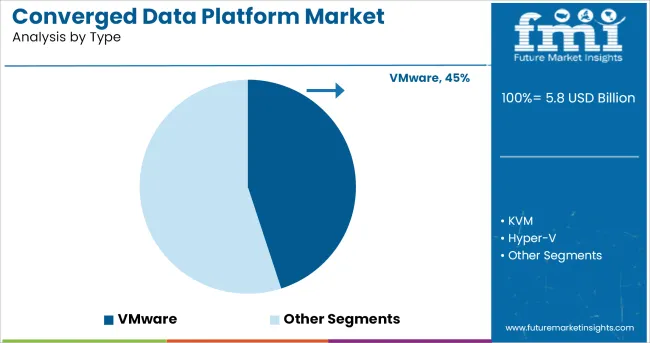
Within the type segment, VMware is projected to hold a dominant 45.0% revenue share in the converged data platform market in 2025. This leadership has been achieved through the widespread deployment of VMware’s hypervisor and virtualization software within enterprise IT infrastructure.
The platform’s ability to deliver consistent virtualization environments across on-premises and cloud infrastructure has positioned it as a preferred solution for hybrid IT strategies. VMware’s ecosystem has been further strengthened by integration with software defined networking and storage layers, allowing greater automation and efficiency in managing workloads.
Enterprises have increasingly favored VMware’s solutions due to their strong support for workload mobility, disaster recovery, and policy based management. Vendor alliances with major hardware and cloud providers have reinforced its market position by enabling seamless deployment of converged platforms. The consistent evolution of VMware’s architecture to support modern applications and multi cloud orchestration continues to sustain its growth trajectory in the segment.
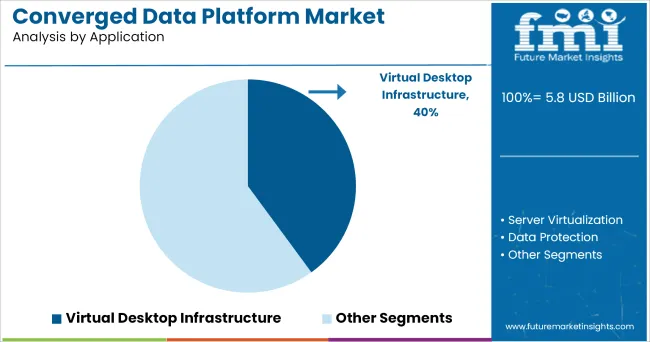
Virtual Desktop Infrastructure (VDI) is expected to account for 40.0% of the overall application revenue share in 2025, making it the leading application in the converged data platform market. This dominance is underpinned by the increasing shift toward remote workforces and the need for secure, centralized management of virtual desktops.
Organizations have adopted VDI to improve end-user computing experiences while maintaining tighter control over data access, especially in highly regulated industries. The use of converged platforms for VDI has gained momentum due to their ability to scale rapidly and deliver predictable performance with simplified management.
The high storage IOPS requirements of VDI workloads are efficiently met through integrated storage and compute capabilities. Additionally, VDI deployments have benefited from built-in redundancy, ensuring business continuity. With rising cyber threats and growing demand for endpoint security, the converged infrastructure supporting VDI environments has become a strategic investment for enterprises seeking flexibility, resilience, and compliance.
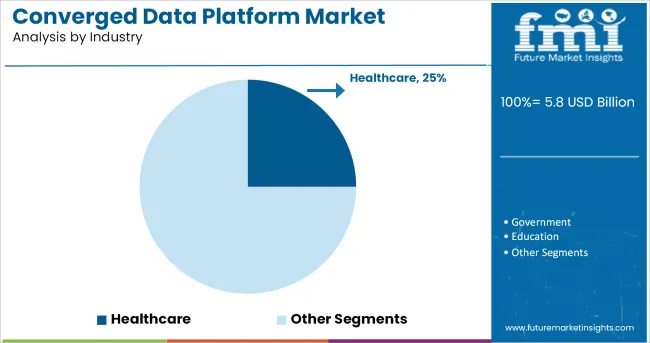
The healthcare industry is anticipated to represent 25.0% of the converged data platform market revenue share in 2025, positioning it among the top end-use sectors. Growth in this segment is being driven by the increasing need for secure, compliant, and high-performance data platforms to manage electronic health records, imaging data, and patient care analytics. Hospitals, clinics, and research institutions are increasingly adopting converged platforms to support real-time access to critical patient information and to ensure system uptime during emergencies.
Healthcare organizations are under pressure to modernize IT infrastructure in alignment with data protection regulations such as HIPAA and GDPR. The integration of converged systems has enabled IT teams to centralize data operations, improve disaster recovery planning, and reduce operational complexity.
Moreover, the rise of telemedicine and AI-driven diagnostics has increased the demand for scalable platforms that can support data intensive workloads. As healthcare shifts toward more connected and digitally driven delivery models, converged data platforms are expected to remain essential to managing complexity and maintaining compliance.
According to the latest research, the Converged Data Platform market is estimated to witness growth with an expected CAGR of around 15%. The converged data platform adoption is increasing due to growing need for data protection and disaster recovery.
Converged infrastructure is an IT framework that combines elements like storage, computing, hypervisor, and networking in single system. Adoption of converged infrastructure helps to reduce data complexity and increase scalability. Converged uses software and x86 servers to replace expensive and purpose-built hardware. Convergence simplifies the planning process and deploying virtual desktop infrastructure in organizations.
It eliminates the up-front design and integration required when large virtual desktop infrastructure systems are deployed. Convergence helps to ease the management of the entire system and improve the performance of virtual desktop infrastructure.
Implementation of virtual desktop infrastructure in a traditional infrastructure is a complex process. But it is easier to implement virtual desktop infrastructure in converged infrastructure as hyper convergence has the ability to add or remove nodes.
Converged data platform is deployed in order to ensure that expensive and mission critical security systems are functioning efficiently. In this instance, IT converged data platform refer to network monitoring tools.
One such example is firewall, which protects user’s data and enables secure Internet connectivity. Companies such as Animate Inc. and LexCloud.ca frequently identify and fix problems with client firewalls before these problems are detected at firms being monitored
Converged data platform facilitates reduction in downtime and investigation time when problems do occur. With enterprises striving to avoid financial losses caused by undetected system failures, they are readily adopting a number of converged data platform for various stages of operations.
Converged data platform facilitates deployment of new technologies and upgradation of infrastructure with safety and ease. This improves enterprises’ time to market for new strategies and product introduction. Rapid and successful deployment of operations with better monitoring capability, coupled with pre- and post-tests, improves initial performance and reduces deployment time.
Deployment of new technologies involves changes to infrastructure, posing significant financial risks to enterprises. Thus the advantages offered by converged data platform such as readiness assessments, bandwidth measurements, traffic composition, outsourced performance levels, and server utilization are expected to drive growth of the market during the forecast period.
All these performance management quantifiers facilitate reduction of time to market and tones down the financial risk induced by changes to the enterprises’ IT infrastructure.
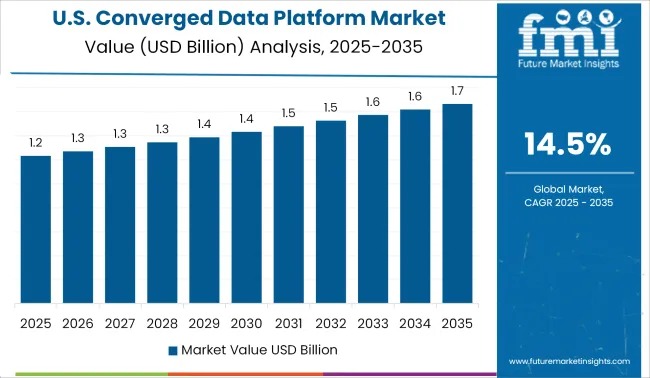
In North America, the adoption of desktop-as-a-service started with small and medium sized organizations migrating to this service model primarily through evolution of their service partner delivering hosting and managed desktop services. Most of the DaaS vendors entered in the market and are partnering with the converged data platform vendors to leverage platform agility and offer customer choice.
However, for security and compliance requirements, organizations will require dedicated hosting platforms. So most of the converged data platform providers in the region are focusing on offering converged data platform with enhanced security options. This strategy can help the vendors to enhance customer base and end user experience in order to reach new growth avenues.
With the growing adoption of cloud computing solutions and improved cloud readiness ranking of countries in South Asia Pacific, the converged data platform market is expected to witness potential growth opportunities in this region.
Also, this region is witnessing rapid growth in IT infrastructure and rising penetration of smart devices and internet. Therefore, converged data platform providers can focus on expanding their operations in countries of this regions to reach new growth avenues.
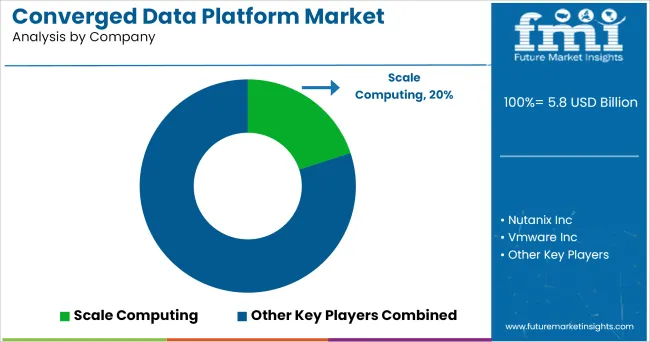
Some of the leading Converged Data Platform providers include
These vendors have adopted various key strategies, to enhance the customer base globally and locally. Companies are also spending millions of dollars into product R&D to fulfill the unmet needs of their customers. Furthermore, many companies are focusing on inorganic strategies by acquiring small and mid-sized organizations present in this market.
The report is a compilation of first-hand information, qualitative and quantitative assessment by industry analysts, inputs from industry experts and industry participants across the value chain.
The report provides in-depth analysis of parent market trends, macro-economic indicators and governing factors along with market attractiveness as per segments. The report also maps the qualitative impact of various market factors on market segments and geographies.
The global converged data platform market is estimated to be valued at USD 5.8 billion in 2025.
The market size for the converged data platform market is projected to reach USD 22.6 billion by 2035.
The converged data platform market is expected to grow at a 14.5% CAGR between 2025 and 2035.
The key product types in converged data platform market are vmware, kvm and hyper-v.
In terms of application, virtual desktop infrastructure segment to command 40.0% share in the converged data platform market in 2025.






Our Research Products

The "Full Research Suite" delivers actionable market intel, deep dives on markets or technologies, so clients act faster, cut risk, and unlock growth.

The Leaderboard benchmarks and ranks top vendors, classifying them as Established Leaders, Leading Challengers, or Disruptors & Challengers.

Locates where complements amplify value and substitutes erode it, forecasting net impact by horizon

We deliver granular, decision-grade intel: market sizing, 5-year forecasts, pricing, adoption, usage, revenue, and operational KPIs—plus competitor tracking, regulation, and value chains—across 60 countries broadly.

Spot the shifts before they hit your P&L. We track inflection points, adoption curves, pricing moves, and ecosystem plays to show where demand is heading, why it is changing, and what to do next across high-growth markets and disruptive tech

Real-time reads of user behavior. We track shifting priorities, perceptions of today’s and next-gen services, and provider experience, then pace how fast tech moves from trial to adoption, blending buyer, consumer, and channel inputs with social signals (#WhySwitch, #UX).

Partner with our analyst team to build a custom report designed around your business priorities. From analysing market trends to assessing competitors or crafting bespoke datasets, we tailor insights to your needs.
Supplier Intelligence
Discovery & Profiling
Capacity & Footprint
Performance & Risk
Compliance & Governance
Commercial Readiness
Who Supplies Whom
Scorecards & Shortlists
Playbooks & Docs
Category Intelligence
Definition & Scope
Demand & Use Cases
Cost Drivers
Market Structure
Supply Chain Map
Trade & Policy
Operating Norms
Deliverables
Buyer Intelligence
Account Basics
Spend & Scope
Procurement Model
Vendor Requirements
Terms & Policies
Entry Strategy
Pain Points & Triggers
Outputs
Pricing Analysis
Benchmarks
Trends
Should-Cost
Indexation
Landed Cost
Commercial Terms
Deliverables
Brand Analysis
Positioning & Value Prop
Share & Presence
Customer Evidence
Go-to-Market
Digital & Reputation
Compliance & Trust
KPIs & Gaps
Outputs
Full Research Suite comprises of:
Market outlook & trends analysis
Interviews & case studies
Strategic recommendations
Vendor profiles & capabilities analysis
5-year forecasts
8 regions and 60+ country-level data splits
Market segment data splits
12 months of continuous data updates
DELIVERED AS:
PDF EXCEL ONLINE
DataOps Platform Market Size and Share Forecast Outlook 2025 to 2035
Data Science Platform Market Size and Share Forecast Outlook 2025 to 2035
Data Management Platforms Market Analysis and Forecast 2025 to 2035, By Type, End User, and Region
Data Monetization Platform Market Size and Share Forecast Outlook 2025 to 2035
Data Security Posture Management (DSPM) Solutions Market Size and Share Forecast Outlook 2025 to 2035
Data Loss Prevention (DLP) Services Market Size and Share Forecast Outlook 2025 to 2035
Data Pipeline Observability Solutions Market Size and Share Forecast Outlook 2025 to 2035
Data Center Market Forecast and Outlook 2025 to 2035
Datacenter Infrastructure Services Market Size and Share Forecast Outlook 2025 to 2035
Data Acquisition Hardware Market Size and Share Forecast Outlook 2025 to 2035
Data Center Automatic Transfer Switches and Switchgears Market Size and Share Forecast Outlook 2025 to 2035
Data Discovery Market Size and Share Forecast Outlook 2025 to 2035
Data Masking Technology Market Size and Share Forecast Outlook 2025 to 2035
Data Centre Rack Server Market Size and Share Forecast Outlook 2025 to 2035
Data Center Power Management Industry Analysis in Western Europe Size and Share Forecast Outlook 2025 to 2035
Data Center Power Management Industry Analysis in Korea Size and Share Forecast Outlook 2025 to 2035
Data Center Liquid Cooling Market Size and Share Forecast Outlook 2025 to 2035
Data Business in Oil & Gas Market Size and Share Forecast Outlook 2025 to 2035
Data Centre Colocation Market Size and Share Forecast Outlook 2025 to 2035
Data Lake Market Size and Share Forecast Outlook 2025 to 2035

Thank you!
You will receive an email from our Business Development Manager. Please be sure to check your SPAM/JUNK folder too.
Chat With
MaRIA